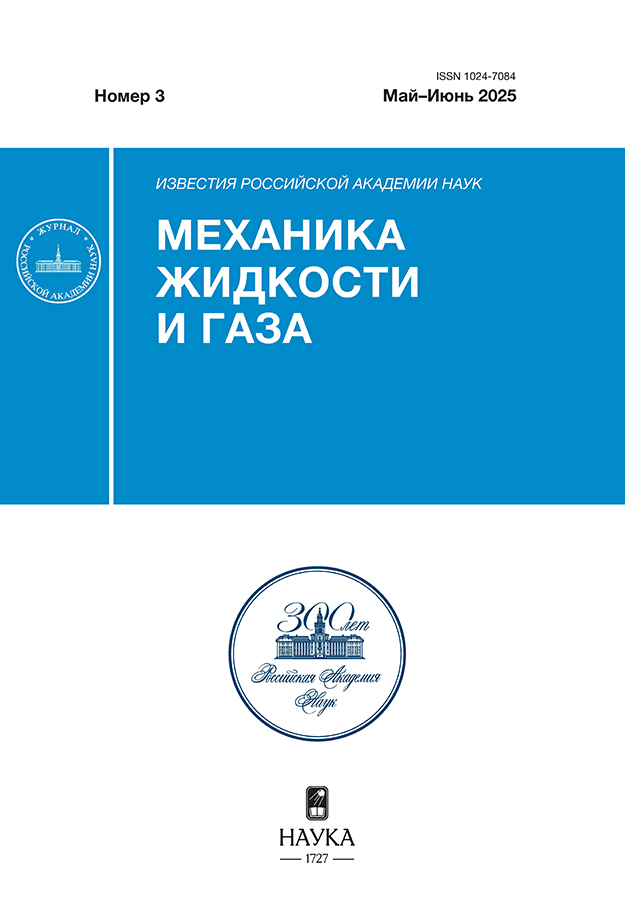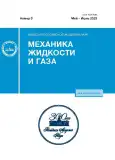Estimation of the Efficiency of Oil Displacement by a Micellar Solution with Addition of Nanoparticles Based on a Bulk Model of Porous Medium
- Authors: Mullayanov A.I.1,2, Pityuk Y.A.1,2
-
Affiliations:
- Ufa University of Sciences and Technologie
- RN-BashNIPIneft LCC
- Issue: No 3 (2023)
- Pages: 103-110
- Section: Articles
- URL: https://journals.rcsi.science/1024-7084/article/view/135098
- DOI: https://doi.org/10.31857/S1024708422600956
- EDN: https://elibrary.ru/TMYHYE
- ID: 135098
Cite item
Full Text
Abstract
The results of laboratory studies of the features of processes of flow through a porous medium are given for a physical model of the porous medium obtained by sintering glass beads. The program for manufacturing physical models is described and the results of the efficiency of displacement of vaseline oil by various compositions are presented. Water, mineralized water, micellar solutions, nanofluids, and micellar solutions with addition of nanoparticles were considered as the displacement agents. Based on an analysis of images, curves of variation in the saturation of the model porous medium with vaseline oil in the process of its displacement by various compositions are obtained. The micellar solutions with addition of nanoparticles were shown to be the most effective oil displacement agents in comparison with other presented compositions.
About the authors
A. I. Mullayanov
Ufa University of Sciences and Technologie; RN-BashNIPIneft LCC
Email: mullayanovalmir@mail.ru
Ufa, Russia; Ufa, Russia
Yu. A. Pityuk
Ufa University of Sciences and Technologie; RN-BashNIPIneft LCC
Author for correspondence.
Email: pityukyulia@gmail.ru
Ufa, Russia/ Ufa, Russia
References
- Honig J.M. Van. Nostrand chemist’s dictionary, 1953.
- Ma K. Adsorption of cationic and anionic surfactants on natural and synthetic carbonate materials // J. Coll. Int. Sci. 2013. V. 408. P. 164–172.
- Winsor P.A. Solvent properties of amphiphilic compounds. Butterworths Sci. Pub. 1954.
- Bera A., Mandal A. Microemulsions: a novel approach to enhanced oil recovery: a review // J. Pet. Explor. Prod. Technol. 2015. V. 5. № 3. P. 255–268.
- Southwick J.G. Effect of live crude on alkaline/surfactant polymer formulations: implications for final formulation design // SPE Journal. 2012. V. 17. № 02. P. 352–361.
- Veiskarami S., Jafari A., Soleymanzadeh A. Phase behavior, wettability alteration, and oil recovery of low-salinity surfactant solutions in carbonate reservoirs // SPE J. 2020. V. 25. № 04. P. 1784–1802.
- Kahlweit M., Lessner E., Strey R. Influence of the properties of the oil and the surfactant on the phase behavior of systems of the type water-oil-nonionic surfactant // J. Phys. Chem. 1983. V. 87. № 24. P. 5032–5040.
- Kahlweit M., Strey R., Busse G. Effect of alcohols on the phase behavior of microemulsions // J. Phys. Chem. 1991. V. 95. № 13. P. 5344–5352.
- Kumar P., Mittal K.L. (ed.). Handbook of microemulsion science and technology. New York: Marcel Dekker, 1999. C. 1–846.
- Thalberg K., Lindman B., Karlstroem G. Phase behavior of a system of cationic surfactant and anionic polyelectrolyte: the effect of salt // J. Phys. Chem. 1991. V. 95. № 15. P. 6004–6011.
- Pizzino A. Relationship between phase behavior and emulsion inversion for a well-defined surfactant (C10E4)/n-octane/water ternary system at different temperatures and water/oil ratios // Ind. Eng. Chem. Res. 2013. V. 52. № 12. P. 4527–4538.
- Kahlweit M., Busse G., Faulhaber B. On the Effect of Acids and Bases on Water – Amphiphile Interactions // Langmuir. 2000. V. 16. № 3. P. 1020–1024.
- Ottewill R.H., Tadros T.F. Introduction to surfactants //Surfactants. 1984. P. 1–18.
- Muherei M.A., Junin R., Merdhah A.B.B. Adsorption of sodium dodecyl sulfate, Triton X100 and their mixtures to shale and sandstone: a comparative study //J. Pet. Sci. Eng. 2009. V. 67. № 3–4. P. 149–154.
- Samanta A. Surfactant and surfactant-polymer flooding for enhanced oil recovery // Adv. Pet. Exp. Dev. 2011. V. 2. № 1. P. 13–18.
- Bera A. Screening of microemulsion properties for application in enhanced oil recovery //Fuel. 2014. V. 121. P. 198–207.
- Yekeen N. Foaming properties, wettability alteration and interfacial tension reduction by saponin extracted from soapnut (Sapindus Mukorossi) at room and reservoir conditions // J. Pet. Sci. Eng. 2020. V. 195. P. 107591.
- Park S., Lee E.S., Sulaiman W.R.W. Adsorption behaviors of surfactants for chemical flooding in enhanced oil recovery //J. Ind. Eng. Chem. 2015. V. 21. P. 1239–1245.
- Izquierdo P. Formation and stability of nano-emulsions prepared using the phase inversion temperature method. Langmuir. 2002. V. 18. № 1. P. 26–30.
- Destefanis M.F., Savioli G.B. Influence of relative permeabilities on chemical enhanced oil recovery // J. Phys. Conf. Ser. 2011. V. 296. № 1. P. 012014.
- Mason T.G. Nanoemulsions: formation, structure, and physical properties // J. Phys. Condens. Matter. 2006. V. 18. № 41. P. R635.
- Karambeigi M.S. Emulsion flooding for enhanced oil recovery: interactive optimization of phase behavior, microvisual and core-flood experiments //J. Ind. Eng. Chem. 2015. V. 29. P. 382–391.
- Qin T. Nanoparticle-stabilized microemulsions for enhanced oil recovery from heterogeneous rocks // Fuel. 2020. V. 274. P. 117830.
- Suleimanov B.A., Ismailov F.S., Veliyev E.F. Nanofluid for enhanced oil recovery // J. Pet. Sci. Eng. 2011. V. 78. № 2. P. 431–437.
- Karimi A. Wettability alteration in carbonates using zirconium oxide nanofluids: EOR implications //E. & F. 2012. V. 26. № 2. P. 1028–1036.
- Zargartalebi M., Kharrat R., Barati N. Enhancement of surfactant flooding performance by the use of silica nanoparticles // Fuel. 2015. V. 143. P. 21–27.
- Hendraningrat L., Zhang J. Polymeric nanospheres as a displacement fluid in enhanced oil recovery // Appl. Nanosci. 2015. V. 5. № 8. P. 1009–1016.
- Pei H.H. Investigation of nanoparticle and surfactant stabilized emulsion to enhance oil recovery in waterflooded heavy oil reservoirs // OnePetro. 2015.
- Комаров Б.Н. О методах измерения поверхностного натяжения жидкостей //Труды Ин-та механики Уфимского научного центра РАН. 2007. Т. 5. С. 227–234.
- Fan Y., Gao K., Chen J., Li W., Zhang Y. Low-cost PMMA-based microfluidics for the visualization of enhanced oil recovery //Oil & Gas Sci. and Tech. 2018. V. 73. P. 26.
Supplementary files















